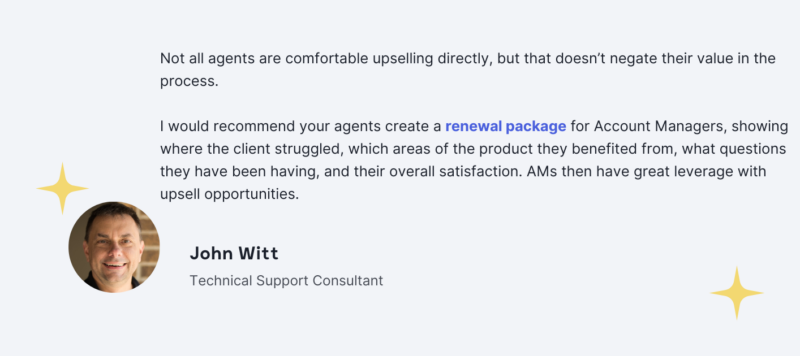Although pressure is universally felt during a recession, the value of customer service is still too often underestimated by companies. Prove that your contact center is not a cost center. Equip them ahead of time so that wading through the turbid waters of a recession will be easier.
How?
This article is about proactively reducing any unnecessary work for customer service teams, so they can add oxygen to the more company-wide effort of reducing customer churn.
During the 2008 recession, the companies that outperformed their peers were the ones who took action earlier in the recession cycle. There’s no time like the present to keep reading.
Q is for quality (always)

Customer service quality is your differentiator. The pandemic has awakened customers to the reality that they don’t have to settle, so you can expect expectations to remain high.
This is not the time to let your quality assurance process fall by the wayside. To illustrate, our benchmark report found an 11% increase in teams conducting quality reviews. You gotta keep up.
A word from one of our own data magicians on how data analysis is your QA friend:
The key is consistency. Setting simple solid KPIs and monitoring them consistently beats one off elaborate ad hoc analysis. Because everything is relative, signs of trouble manifest as changes to some baseline. Consistently keeping an eye on that baseline makes you better equipped to spot if something is off. A smart baseline is not just looking at average but some range that gives more perspective on a metric – like 25th and 75th percentile.
Knowing how to focus on the most important is key. Being able to immediately zoom in on areas that deviate from baseline ultimately saves time and effort.
Mervi Sepp Rei, PhD
Keeping on top of quality doesn’t eat up time. When you conduct quality assurance reviews, your aim is not to cover as many interactions as possible. It’s to pluck out the ones that are sounding an alarm so that you can turn that alarm off.
P is for proactive (sometimes it’s for parrot)
Adopt a proactive mindset and cut the more basic customer questions off at the pass. This will save your team time for the more complex issues – the ones that require human touch.
How? Call in the doc…umentation.
External documentation
Firstly, I want to remind you of the movie Groundhog Day. Remember when Bill Murray was doomed to repeat the same day time and time again? That’s what work can be like on some days for 40% of customer service teams.
Disclaimer: we didn’t ask them how akin their life was to Groundhog Day, but we did ask what their biggest challenge was, and they answered ‘repetitive requests.’ For the other 60%, it might not be within their biggest challenges, but I imagine it’s still a challenge for many.
Every time your support team answers an oft-asked question, they could be spending time on more complex matters that require a human (not a parrot, nor a chatbot).
You likely already have some knowledge base or help center for customers. A knowledge base on the company website is the second most important tool for a customer support team (only beaten by a help desk system).
But is your knowledge base thorough enough? Is it a neglected FAQ page? Is it akin to an old filing system gathering digital dust in a forgotten corner of your website?
Make your customer service team’s work life a little less Groundhog Day-esque – give your customers the answers before they contact support.
Designate someone the responsibility of:
- Reviewing your knowledge base routinely.
- Spotting trends in customer questions and adding new answers regularly.
- Making the knowledge base easily findable and searchable.
This someone depends on the structure of your team. It can be your QA specialist, team leaders, or you can even incorporate it into a regular team workshop. On the whole, the issue is less about who does it and more about it getting done.

Customer Service Quality Benchmark Report 2022
A little number crunching:
The average help center in B2B tech companies gets 1,027 views per month.
The average support team in this industry deals with 594 tickets per month.
Shout out to Zendesk’s interactive benchmark report for the raw figures.
Let’s say 70% of those help center visitors found the answer they were looking for, but in 30% of the cases their issue was too complex to find a solution. Of course, in these instances they contact support.
If that were the case, the average monthly ticket number would reduce by over 700 tickets. While the percentages are a guesstimate, the principle holds out: thorough knowledge bases reduce ticket numbers.
In fact, customers want to find the answers independently. Help them do that.
Subsequently, if the chatbot route is one you’ve decided to go down, these are the kinds of questions that they should be handling – the simple, repetitive ones.
Tip: Your knowledge base doesn’t have to consist of reams of black & white articles. Add color, videos, interactive tutorials, etc – check out Stonly and Helpjuice if you want help making them thorough and attractive.

Internal documentation
Stimulating a sharing culture makes your team more than a sum of their parts. An exhaustive internal knowledge base is a strong, low-cost baseline for this.
The majority of agents in enterprise businesses struggle to find the information they need to meet customer expectations. Give them a single source of truth so that answers can be found and delivered faster and more consistently. This makes your support team as consistent as they are efficient.
While you likely already have set guidelines for training purposes and product guides, expand these to fill as many support case scenarios as possible (and make this an ongoing process!).
Map out complex scenarios and review guidelines regularly: e.g., with each new product feature. Update your support team’s manual and already you are saving them time.
R is for reducing (sometimes it’s for radishes)
What you want to reduce is customer churn.
Existing customers are the bag of magic beans you need to hold onto during a recession. It’s well reported that acquiring new customers is a far more costly endeavor than keeping existing ones.

You don’t have to undergo a lengthy training program to turn your support agents into a second division of the sales team. The customer service team’s value lies in being your company’s earpiece and mouthpiece. Listen in 👂
Reducing churn by strengthening the customer feedback loop
Your customer feedback loop is the cycle of feedback between customers and businesses. The companies that are more flexible are also more resilient – the shape-up cycle is optimum when it can bend to requests. If this feedback loop is strong, what your customers say feeds directly into development.
Contact centers make sure this cycle is well-oiled. Train support agents to collect feedback on every stage of the customer journey and relay it to product & development. The tighter this process, the better.
Finally, make sure that the customer’s influence is made known. Show off – if a customer’s problem affected the roadmap, tell them!
Reducing churn by reinforcing engagement & upselling
The more your support agents know about the product and the customer, the better they are at improving engagement. Clue them up on the product pipeline so they know everything they need to about any recent updates, upcoming features, etc.
Turn your customer service team into product advocates. If you track Feature usage, Customer health score and/or NPS, your customer service team can understand customer usage better.
John Witt provides a growth plan that lets your team shine simply by nurturing information exchange and without extensive sales training for your agents:
If you want to review how well your customer service team is doing at improving customer engagement and upselling, make it an aspect of your QA scorecard. These are some categories Zendesk QA users include:
- Demo offered
- Product knowledge
- Engagement
Equip your customer service team for a recession now
(a summary)
Q is for quality
Customer expectations will not lower. Protect your quality by reviewing consistently and understanding your baseline. So, look at the outlying conversations to detect when problems start brewing.
P is for proactive
Repetitive requests eat up too much of your team’s time. Is someone regularly checking and updating your internal and external documentation? If the answer is no, change that.
R is for reducing churn.
Customers are golden. Treat them this way by strengthening your customer feedback loop. Chart the potential for increased revenue by listening to your customers and passing the information to account managers.


